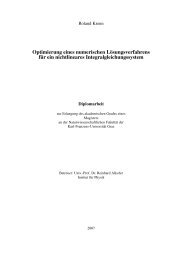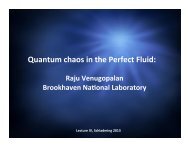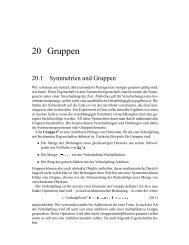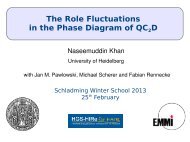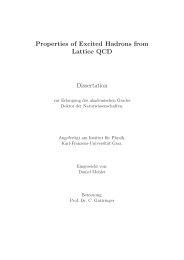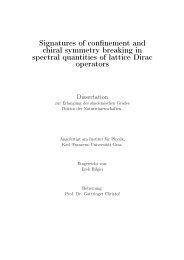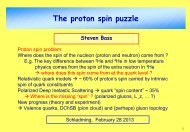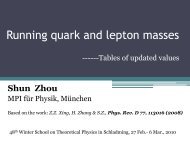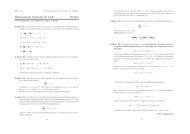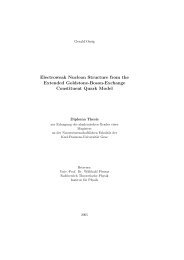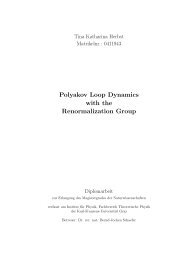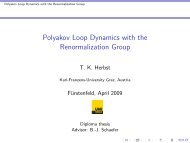The QCD Quark Propagator in Coulomb Gauge and - Institut für Physik
The QCD Quark Propagator in Coulomb Gauge and - Institut für Physik
The QCD Quark Propagator in Coulomb Gauge and - Institut für Physik
Create successful ePaper yourself
Turn your PDF publications into a flip-book with our unique Google optimized e-Paper software.
84 6.5. Nucleon electromagnetic form factors: results<br />
Form factor ratios<br />
In figure6.5 we plot the ratio µ p G p E (Q2 )/G p M (Q2 ). <strong>The</strong> behaviour of the experimental<br />
data at small Q 2 is readily understood. In the neighbourhood of Q 2 = 0,<br />
G p E<br />
µ (Q2 )<br />
p<br />
G p M (Q2 ) = 1 − Q2<br />
6<br />
[<br />
(rp ) 2 − (r µ p )2] , (6.98)<br />
<strong>and</strong> because r p ≈ r µ p the ratio varies by less than 10% on 0 < Q 2 < 0.6 GeV 2 , if the form<br />
factors are approximately dipole. This is evidently true of the experimental data. In our<br />
calculation, without chiral corrections, table 6.2 <strong>and</strong> 6.3, r p > r µ p. Hence the ratio must fall<br />
immediately with <strong>in</strong>creas<strong>in</strong>g Q 2 . Incorporat<strong>in</strong>g pion loops, we obta<strong>in</strong> the results <strong>in</strong> Row 2<br />
of table6.5, which have r p ≈ r µ p. <strong>The</strong> small Q 2 behaviour of this ratio is thus materially<br />
affected by the proton’s pion cloud.<br />
True pseudoscalar mesons are not po<strong>in</strong>tlike <strong>and</strong> therefore pion cloud contributions to<br />
form factors dim<strong>in</strong>ish <strong>in</strong> magnitude with <strong>in</strong>creas<strong>in</strong>g Q 2 . For example, <strong>in</strong> a study of the<br />
γN → ∆ transition [SL01], pion cloud contributions to the M1 form factor fall from 50% of<br />
the total at Q 2 = 0 to ∼<br />
< 10% for Q 2 2 GeV 2 . Hence, the evolution of µ p G p E (Q2 )/G p M (Q2 )<br />
on Q 2 2 GeV 2 is primarily determ<strong>in</strong>ed by the quark core of the proton. This is evident<br />
<strong>in</strong> figure6.5, which illustrates that, on Q 2 ∈ (1, 5) GeV 2 , µ p G p E (Q2 )/G p M (Q2 ) is sensitive<br />
to the parameters def<strong>in</strong><strong>in</strong>g the axial-vector-diquark–photon vertex. <strong>The</strong> response dim<strong>in</strong>ishes<br />
with <strong>in</strong>creas<strong>in</strong>g Q 2 because our parametrisation expresses the perturbative limit,<br />
equation(6.78).<br />
<strong>The</strong> behaviour of µ p G p E (Q2 )/G p M (Q2 ) on Q 2 2 GeV 2 is determ<strong>in</strong>ed either by correlations<br />
expressed <strong>in</strong> the Faddeev amplitude, the electromagnetic properties of the constituent<br />
degrees of freedom, or both. <strong>The</strong> issue is decided by the fact that the magnitude <strong>and</strong> trend<br />
of the results are not materially affected by the axial-vector-diquarks’ electromagnetic parameters.<br />
This observation suggests strongly that the ratio’s evolution is due primarily<br />
to sp<strong>in</strong>-isosp<strong>in</strong> correlations <strong>in</strong> the nucleon’s Faddeev amplitude. One might question this<br />
conclusion, <strong>and</strong> argue <strong>in</strong>stead that the difference between the results depicted for set A<br />
cf. set B orig<strong>in</strong>ates <strong>in</strong> the larger quark-core nucleon mass obta<strong>in</strong>ed with set B (table 6.1)<br />
which affects G p E (Q2 ) through equation(6.50). We checked <strong>and</strong> that is not the case. Beg<strong>in</strong>n<strong>in</strong>g<br />
with the set B results for F 1,2 we calculated the electric form factor us<strong>in</strong>g the set A<br />
nucleon mass <strong>and</strong> then formed the ratio. <strong>The</strong> result is very different from the <strong>in</strong>ternally<br />
consistent set A b<strong>and</strong> <strong>in</strong> figure6.5; e.g., it drops more steeply <strong>and</strong> lies uniformly below,<br />
<strong>and</strong> crosses zero for Q 2 ≈ 3.7 GeV 2 .<br />
It is noteworthy that set B, which anticipates pion cloud effects, is <strong>in</strong> reasonable agreement<br />
with both the trend <strong>and</strong> magnitude of the polarisation transfer data [J + 00, G + 01,



